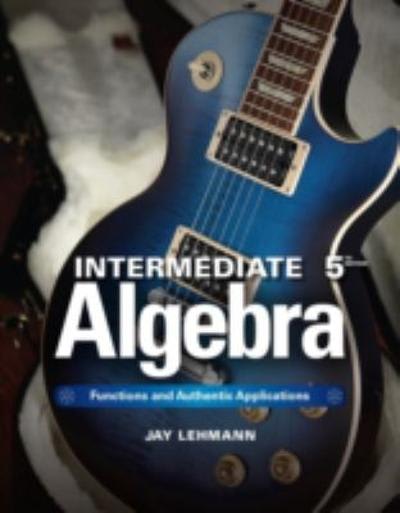Question
1This question has several parts that must be completed sequentially. If you skip a part of the question, you will not receive any points for
1This question has several parts that must be completed sequentially. If you skip a part of the question, you will not receive any points for the skipped part, and you will not be able to come back to the skipped part.
Tutorial Exercise
A normal distribution has=29and= 4.(a) Find thezscore corresponding to
x=25.
(b) Find thezscore corresponding to
x=39.
(c) Find the raw score corresponding to
z=3.
(d) Find the raw score corresponding to
z=1.2.
Step 1
(a) Find thezscore corresponding to
x=25.
Recall that thezscore gives the number of standard deviations between the original measurementxand the meanof thexdistribution. It can be calculated using the following equation.
z=
| x |
We are given=29and= 4. Calculate thezscore whenx=25.
| z | = |
| ||
| = |
| |||
| = |
| |||
| = |
2
A normal distribution has=30and= 5.(a) Find thezscore corresponding to
x=25.
(b) Find thezscore corresponding to
x=42.
(c) Find the raw score corresponding to
z=3.
(d) Find the raw score corresponding to
z=1.7.
3
Fawns between 1 and 5 months old have a body weight that is approximately normally distributed with mean=29.9kilograms and standard deviation=4.3kilograms. Letxbe the weight of a fawn in kilograms.Convert the followingxintervals tozintervals. (Round your answers to two decimal places.)(a) x<30 z< (b) 19<x <z (c) 32<x<35 <z< Convert the followingzintervals toxintervals. (Round your answers to one decimal place.)(d) 2.17<z <x (e) z<1.28 x< (f) 1.99<z<1.44 <x< (g) If a fawn weighs 14 kilograms, would you say it is an unusually small animal? Explain usingzvalues and the figure above.Yes. This weight is 3.70 standard deviations below the mean; 14 kg is an unusually low weight for a fawn.Yes. This weight is 1.85 standard deviations below the mean; 14 kg is an unusually low weight for a fawn. No. This weight is 3.70 standard deviations below the mean; 14 kg is a normal weight for a fawn.No. This weight is 3.70 standard deviations above the mean; 14 kg is an unusually high weight for a fawn.No. This weight is 1.85 standard deviations above the mean; 14 kg is an unusually high weight for a fawn. (h) If a fawn is unusually large, would you say that thezvalue for the weight of the fawn will be close to 0,2, or 3? Explain.It would have a large positivez, such as 3.It would have a negativez, such as2. It would have azof 0.
4
Letx= red blood cell (RBC) count in millions per cubic millimeter of whole blood. For healthy females,xhas an approximately normal distribution with mean=3.5and standard deviation=0.2.(a) Convert thexinterval, 4.5<x, to azinterval. (Round your answer to two decimal places.) <z (b) Convert thexinterval,x<4.2, to azinterval. (Round your answer to two decimal places.) z< (c) Convert thexinterval, 4.0<x<5.5, to azinterval. (Round your answers to two decimal places.) <z< (d) Convert thezinterval,z<1.44, to anxinterval. (Round your answer to one decimal place.) x< (e) Convert thezinterval, 1.28<z, to anxinterval. (Round your answer to one decimal place.) <x (f) Convert thezinterval,2.25<z<1.00, to anxinterval. (Round your answers to one decimal place.) <x< (g) If a female had an RBC count of 5.9 or higher, would that be considered unusually high? Explain usingzvalues.Yes. Azscore of 12.00 implies that this RBC is unusually high.No. Azscore of12.00 implies that this RBC is unusually low. No. Azscore of 12.00 implies that this RBC is normal.
5
Sketch the area under the standard normal curve over the indicated interval and find the specified area. (Round your answer to four decimal places.)The area to the right ofz= 0 is .
6
Sketch the area under the standard normal curve over the indicated interval and find the specified area. (Round your answer to four decimal places.)The area to the left of
z=1.34
is
7
Sketch the area under the standard normal curve over the indicated interval and find the specified area. (Round your answer to four decimal places.)The area to the left of
z=0.54
is .
8
Sketch the area under the standard normal curve over the indicated interval and find the specified area. (Round your answer to four decimal places.)The area to the right ofz=1.63is .
9
Sketch the area under the standard normal curve over the indicated interval and find the specified area. (Round your answer to four decimal places.)The area to the right ofz=0.22is .
10
Sketch the area under the standard normal curve over the indicated interval and find the specified area. (Round your answer to four decimal places.)The area to the right of
z=1.15
is .
11
Sketch the area under the standard normal curve over the indicated interval and find the specified area. (Round your answer to four decimal places.)The area betweenz= 0 andz=2.58is .
12
Sketch the area under the standard normal curve over the indicated interval and find the specified area. (Round your answer to four decimal places.)The area between
z=2.29
andz=1.42is .
13
Letzbe a random variable with a standard normal distribution. Find the indicated probability. (Round your answer to four decimal places.)
P(z1.97)
= Shade the corresponding area under the standard normal curve.
Step by Step Solution
There are 3 Steps involved in it
Step: 1

Get Instant Access to Expert-Tailored Solutions
See step-by-step solutions with expert insights and AI powered tools for academic success
Step: 2

Step: 3

Ace Your Homework with AI
Get the answers you need in no time with our AI-driven, step-by-step assistance
Get Started


